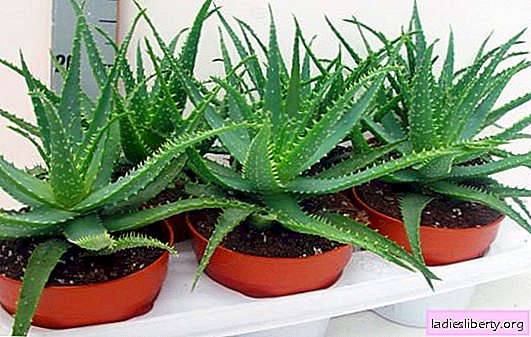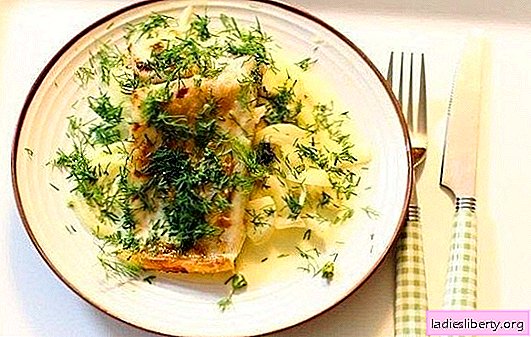
Aloe (agave) is a popular houseplant with many medicinal properties.
It does not require special care and is rarely attacked by pests and diseases.
Aloe tolerates heat, drought, but does not like waterlogging and excessive shading.
Light and temperature
Aloe indoor is a photophilous plant, easily tolerates exposure to direct sunlight. From the end of spring to the beginning of autumn, the plant can be carried out to a well-lit balcony. In summer, the ideal temperature for aloe is 23-27 degrees, and in winter 14-18. At temperatures below 5 degrees, the flower may die.
In an apartment, the agave is best kept on a window facing the south or southeast side. If the plant began to fade in the summer, then rearrange it in a slightly shaded place. Aloe does not need to be sprayed, but it must be periodically cleaned from dust with a damp cloth (napkin).
In winter, the plant is at rest, but should not be kept in a dark place. If aloe wintered on a shaded window sill, then by the beginning of summer it must be hardened. To do this, gradually increase its time spent in a sunny place, otherwise, the healing leaves of aloe will receive sunburn.
Transplant: how to care for aloe in a new place
The centenar needs a transplant once every 2-3 years. The plant will feel best in a clay pot, but taking good care of aloe, you can achieve good growth when planting in a plastic pot.
The best soil for planting aloe is a soil mixture for cacti and succulents. It should consist of turf land, humus, sheet land and coarse sand in a ratio of 2: 1: 1: 1. Perhaps the addition of charcoal and broken bricks for friability and disinfection.
Cactus and succulent or universal mineral fertilizers are used as top dressing for aloe. During the period of growth and development (from mid-spring to early autumn), the plant is fertilized twice a month, and is not fed at all in winter.
Watering
Agave does not need frequent watering. From April to October, it is better to water it 1-2 times a week, and during the rest period (from October to March) - once every two weeks. To do this, use the settled water slightly above room temperature.
When watering, focus on the complete drying of the top layer of the soil, preventing its overmoistening. Stagnant water can cause rotting of the root system, which will lead to an early death of the flower. The best way to irrigate is to radically moisten the soil with a watering can.
When watering, water should not fall into the folds of aloe between the leaves. If this happens, wipe it dry with a cotton swab, otherwise the neck of the plant may rot.
Reproduction: how to care for the processes of aloe
- Propagation by cuttings (lateral shoots) is best done in the warm season. To do this, peel off the base of the aloe with a sharp knife. Sprinkle slices with charcoal or activated charcoal.
Dry the roots in a dark place for 1-2 days and begin to grow the roots. To do this, plant young cuttings in moist sand, having buried a maximum of 1 cm, and the distance between the children should be 4-5 cm. Make sure that the sand is always wet.
After a week, the cuttings can be planted in separate pots. For planting, you need fragments of red broken brick and soil for cacti. Watering and caring for aloe should be the same as for an adult plant.
- Reproduction by leaf is carried out almost as well as by cuttings. Cut the aloe leaf at the base with a sharp knife and place in a dark place for a couple of days to dry the slice. After planting in wet sand to a depth of 3 cm to build roots.
- Reproduction by children is the easiest way, since young growth already has its own formed root system. The child must be carefully dug up and planted in a mixture of turf and leafy soil, humus and sand, you can also add broken brick to the bottom of the pot.
- Reproduction by the tip is as follows: cut the tip so that it has 5-7 leaves. Place in a glass of water to grow roots. And after their formation, transplant into a separate pot.
- Reproduction by seeds is a very laborious and long process. Plant the seeds in a soil mixture of turf land, sand, humus and leaf soil in a ratio of 2: 2: 1: 1. In this case, the air temperature should not be lower than 20 degrees. Young seedlings then need to be dived into shallow boxes with the same soil. After a year, in the warm season, young plants need to be trans-shipped.
Diseases and pests: how to care for aloe to prevent their appearance
The main danger to the agave is the decay of the neck and root system. This problem appears as a result of improper care of aloe and most often leads to its death. If this still happened, you can try to immediately save the plant.
1. Remove the plant from the pot.
2. Rinse the roots under a stream of warm water.
3. Inspect the root system carefully: leave strong light roots and remove all soft brown ones.
4. Plant the flower in fresh soil for cacti and succulents with a high content of sand.
5. If there are no healthy roots at all, root the top or leaves in water or sand.
Aloe is affected by rot due to flooding of the roots. This occurs due to the lack of a drainage layer and with too frequent watering. Therefore, after transplanting the plant into fresh soil, water it only after the top layer is completely dry.
When the agave is damaged by dry rot, the leaves dry out from the inside, and the flower cannot be cured. To prevent this disease, periodic spraying of the plant with systemic fungicides is recommended.

Elongated stems and aloe leaves indicate excessive watering in winter and lack of sunlight. Therefore, provide the plant with good lighting and adjust the watering.
Most often, scarlet is exposed to scale insects. They are brown elongated plaques on the upper and lower sides of the plant leaf. To deal with them, follow these steps:
• moisten a cotton swab in vinegar or alcohol;
• use it to remove pests;
• treat scarlet with insecticides.

Nematodes can damage the root system of the agave. Therefore, to combat them, damaged roots are removed and the plant is rooted again. When watering the soil, additional preparations of Tekta and Vidat are used.











